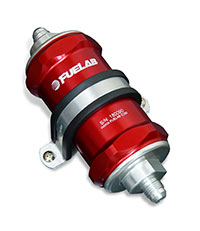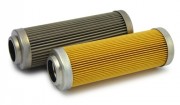Pre and Post Pump Fuel Filter Considerations:
Most mechanics know that almost every fuel system has two fuel filters. These two filters serve two very different purposes and therefore have very different attributes. While everyone thinks about "Post – Pump" filters, many do not consider the "Pre – Pump" filters. Often called "Straining Filters", these coarse filters are responsible for preventing debris in the fuel from being able to lock-up or damage the fuel pump.
The filters are typically very coarse in nature, particularly in high flow applications. This filter is coarse, not just to reduce pressure drop, but to ensure that fine debris will not begin to block flow over time. Fuelab uses a 100 micron rating for its straining filters (including the in-tank filter Model 83801). Fuelab also recommends the filter rating be between 75 and 150 microns for the "Pre – Pump" filter, when using their fuel pumps. While it may be tempting to use a finer (lower micron rating) filter upstream from the fuel pump, it can lead to pump failure. Not only are finer filters more restrictive, but they can increase in pressure drop over time. If the pressure drop across this filter becomes enough, the fuel pump can cavitate (boiling or vaporizing of the fuel). The same amount of pressure drop after the pump, however would not cause this failure. The "Post – Pump" filter is typically the filter that is replaced on vehicles as part of normal maintenance, while straining filters are typically installed inside the fuel tank itself (and not a part of normal maintenance).
Considerations for this filter include:
- Fuel Type. Filter material or media can have compatibility issues. Use of fuels like E-85 can causes problems with normal "paper" filters. Be sure that the filter you use is compatible with the fuel you intend to use.
- Filtration. The micron rating relates to the size of the particle that is blocked (or stopped, depending on the type of rating). The finer (smaller the value) the filter is, the smaller the particles of debris that get filtered.
- Capacity. Filters can have two ratings with respect to capacity. Sometimes they are given a general flow rating, or simply demonstrate the total filter surface area. It may be obvious, but worth noting: In general the larger the filter is, the larger the capacity. Having larger filters can help reduce maintenance frequency as well as improve flow capacity.



You must login to post comments.